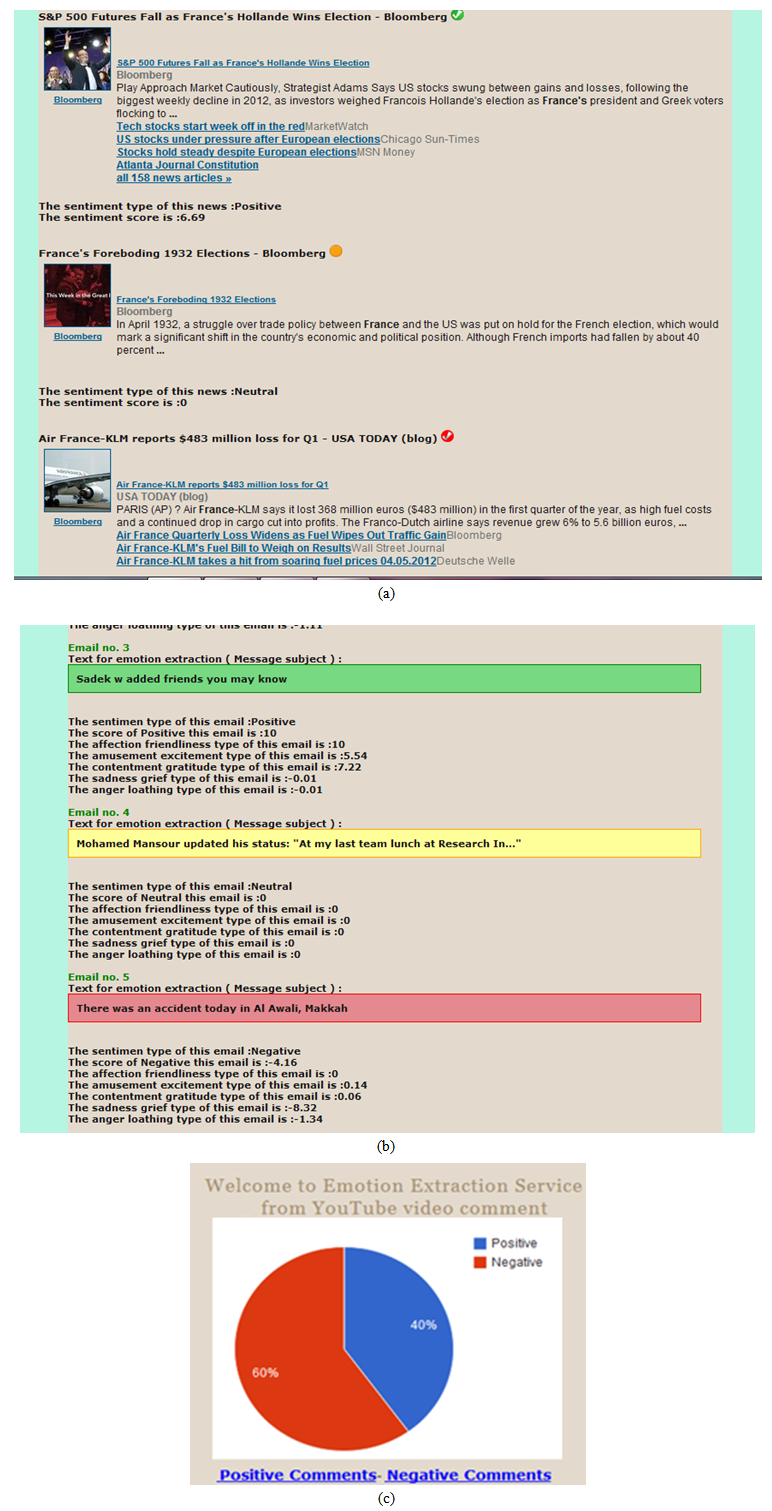-
Paper Information
- Paper Submission
-
Journal Information
- About This Journal
- Editorial Board
- Current Issue
- Archive
- Author Guidelines
- Contact Us
Advances in Computing
p-ISSN: 2163-2944 e-ISSN: 2163-2979
2014; 4(2): 31-40
doi:10.5923/j.ac.20140402.01
Emotion-Based System for Social Media Content Processing and Event Monitoring
Mohamed Abdur Rahman , Mohamed A. Ahmed
Advanced Media Laboratory, Computer Science Department, College of Computer and Information Systems, Umm Al-Qura University, Makkah Al Mukarramah, Kingdom of Saudi Arabia
Correspondence to: Mohamed A. Ahmed , Advanced Media Laboratory, Computer Science Department, College of Computer and Information Systems, Umm Al-Qura University, Makkah Al Mukarramah, Kingdom of Saudi Arabia.
| Email: |  |
Copyright © 2014 Scientific & Academic Publishing. All Rights Reserved.
In this paper, we propose an open source web-based emotion retrieval service for textual social media contents, called MediaTagger, which can extract emotional value from online content coming from diversified Internet-based services. MediaTagger mashes up state of the art emotion services and allocates the right emotion retrieval service using several emotion visualization metaphors based on the content of each service. MediaTagger also incorporates a flexible and adaptable emotion authoring service based on Naïve Bayes machine learning theorem. The authoring service within the system also helps creating new domains of emotion extraction services. We share some quantitative and qualitative results that show the viability of our system as well as the experience and satisfaction of regular end-users. We will describe a case study that leverages the features provided by the MediaTagger. This study shows the utilization of emotion-based textual posts for monitoring and decision-support systems during major events such as Hajj.
Keywords: Social Media, Emotion Mashup, Multimedia
Cite this paper: Mohamed Abdur Rahman , Mohamed A. Ahmed , Emotion-Based System for Social Media Content Processing and Event Monitoring, Advances in Computing, Vol. 4 No. 2, 2014, pp. 31-40. doi: 10.5923/j.ac.20140402.01.
Article Outline
1. Introduction
- We are surrounded with a lot of user generated content, thanks to the widespread acceptance of social networks. Examples include blogs, RSS news feeds, social networks such as Twitter, Email messages, image/video sharing services. Contents from each source have emotional value to the information producer [1]. People leave their emotional footprint mostly in diversified social network services in the form of reviews, comments and answers through varieties of media. For example, people upload videos of numerous domains such as weather, technology, news, sports and different products and services. They also provide comments about those entities while expressing their emotions. However, the text containing user emotion about weather for example does not have same emotional value as the user comments about the review of Microsoft Kinect as an XBOX sensor. This leads to the fact that for every domain of knowledge, user emotion extraction requires separate emotion extraction knowledge.In [3], the author analyzes the emotion classifications and states from cognition perspective. The work provides a 3D circumplex model that describes the relationships between different emotion possibilities. The authors in [4] present a platform called SenticNet for mining online opinions and discovering human emotions using common sense reasoning, polarity concepts and their own characterization model. In [5], the authors discuss the topic of tagging in general especially handling image and photo tags in Flickr/ZoneTag online services. With the ever growing use of online Web 2.0 tools and especially customer reviews, the authors of [6, 7, 8] analyzed the effect of online customer reviews and emotions on new customer purchases and on branding image, perception and marketing strategies of companies and vendors.In [9], the authors try to classify the sentiment of Twitter posts and trends using machine learning techniques. However, their algorithm needs to refine noisy knowledge and provide option of feedback and control mechanism to update and insert new knowledge. Meanwhile, the authors in [10] analyze keywords within microblog feeds such as Twitter, Plurk and Jaiku to learn about the sentiments of those keywords while visualizing the results using audiovisual interface through music tones (using dynamic arousal and valence values) that represent the sentiment of each microblog post. They make use of several factors such as response, context and friendship in deciding the sentiment labels. Some research is also done on evaluating the mood sentiments of video contents such as the work done in [11] where the authors try to utilize low-level video features such as color and sound that are mapped to their corresponding Valence-Arousal values to determine the emotion within standalone video contents. However, the main issues with that work are that it targets standalone video files and the accuracy rate they provided is relatively low (about 60%).Existing emotion extraction services provide support of a subset of domains as it needs specialized algorithms relevant to each domain. This limits the horizontal scalability. People have to search for those services that provide that type of emotion extraction. Mashing up existing services into one platform would give service consumers a great relaxation in emotion service consumption. In addition to the Mashup of existing services, an authoring process of providing facility to create new domains of emotion extraction service would usher in new era of emotion computing for multimedia contents. We aim to realize those goals in this proposed paper. We also leverage existing open source APIs to mash-up emotion services for both text and image contents. To provide authoring facility, we use Naïve Bayes [12] theorem, which provides both horizontal as well as vertical elasticity of emotion extraction capability. We chose Naïve Bayes theorem because of its great advantages and suitability to our requirements. Advantages of Naïve Bayes theoreminclude its simplicity, superior performance to evensome complex algorithms, scalability, fast training and recognition of multiple classifications. It is proved to provide excellent and fast results to classify new events given their associated features and using the available classified training sets. Thus using Naïve Bayes theorem, we can add new dimension of emotion extraction verticals, by incorporating a dynamic knowledge base that gets adapted continuously through a feedback process that makes use of user expertise, locale and preferences. As a proof of concept, we process Twitter messages, YouTube video reviews, Email messages, weather status feedback, movie reviews, and facial expression from images.The remainder of this paper is organized as following. In section 2 we show the design of our system. Section 3 illustrates the implementation details of our developed system. In section 4 we provide and analyze our collected test results. In section 5, we will present a case study for our system. It is tracking users’ post for monitoring their emotions about a certain past major event which is Hajj. We will provide concluding remarks along with our future objectives in section 6.
2. Description of the System
- As shown in Figure 1, the MediaTagger system has two main modules namely: Web Data Extraction Module and Emotion Extraction Module. The components and functions of each module are described as following:
 | Figure 1. High level components of MediaTagger |
2.1. Web Data Extractor
- Web Data Extractor module is responsible of collecting raw contents from their respective sources. We leverage our open source multimedia content extraction framework called SenseFace [2] to extract live content from heterogeneous Internet-based sources. The framework embeds a suite of protocols and algorithms that can communicate with complex and proprietary sources of existing heterogeneous Internet-based services and retrieve online multimedia content. The framework provides state of the art multimedia content extraction services from diversified mail servers, websites, blogs, video sharing and image sharing sites. To manage load balancing and scalability, the framework uses proxy servers where each proxy server actually listens to each type of content retrieval service request and depending on the number of concurrent service requests, more number of proxy servers may be employed within the system. A proxy server stores the list of content retrieval services available within the framework in XML format. The Web Data Extractor has the following key components, as shown in figure 2.
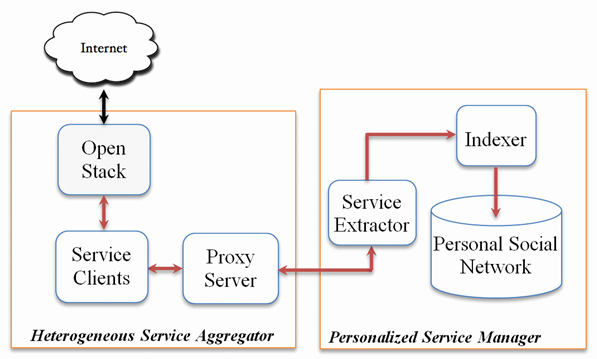 | Figure 2. Salient components of Web Data Extractor |
2.2. Emotion Extractor
- This module is responsible for pre-processing and analyzing content, extracting emotion, indexing the emotion primitives, presenting the results to the user, and in the case of Naïve Bayes theorem, adapting the emotion value from the user feedback to train the system. The module utilizes the MVC (Model/View/Controller) design pattern to extract and present emotions. In its upstream data collection path, the Controller receives raw web content from the Web Data Extractor. The Controller also issues request to extract new media content in downstream path. Upon receiving raw media content, the Controller delegates the content to the model component i.e. Emotion Extraction Logic. This component mashes up all the emotion extraction services available within the framework and delegates the content to the most optimal service, depending on the media and user requirements. It also leverages the metadata of each API in the form of types of media support, response type per unit content, size of each payload per request, types of request and response i.e. JSON, XML, REST, number of requests per API call, type of domain knowledge supported, types of functionalities supported, types of emotional values supported (+ve, -ve, neutral), ranges of emotion value, and sentiment attributes such as affection, friendliness, sadness, amusement, contentment and anger, to name a few. The unit could be horizontally enriched with N number of services.The Emotion Extraction Logic APIs in MediaTagger are of two types: external APIs and those using Naïve Bayes learning theorem. In the former case, the Emotion Extraction Logic simply uses the I/O API methods without any training. In the latter case, it uses Naïve Bayes theorem. Thus, it uses three different working phases. These phases are:1) Training phase:The system makes use of a Naïve Bayes theorem, which is a supervised learning method, to classify the emotion of the retrieved content assuming conditionally independent classification features. Classifications would include positive, negative or neutral sentiments. We use this theorem to evaluate the posterior probability of sentiment membership to classify new input sample according to its associated features (i.e. content text keywords). We do the same for all possible classifications. Thus, it would be easy to classify the new event to be the classification with highest posterior probability. The Naïve Bayes formula is summarized in equation 1 where C is the number of possible classifications.
 | (1) |
2.3. Emotion Primitives
- Emotion Primitives repository stores the emotion primitives, which are the outputs of Emotion Extraction Logic. Each API stores its result to a separate repository. Some APIs use the stored emotion primitives as a training dataset and use their stored emotion data as an input to the emotion extraction logic, which in this system is the Naïve Bayes theorem. This data set gets enriched throughout the lifecycle of the emotion extraction service. The richer the database is, the more accurate the logic would behave.
2.4. View
- The logic of the Emotion Extraction Logic unit is transparent to the user through the View. Through the view interface, a user can give his/her feedback by either accepting or refuting the outcome of the emotion value. At the end of user interaction through the View or user interface, the user’s feedback is stored in the Emotion Primitives repository. In order to aid in visualizing the emotions, we quantize the emotional states for each category by adopting the Hourglass of Emotions, which is an affective categorization model proposed in [4]. A sample of categorization according to the above model is shown in figure 3.
 | Figure 3. Color coded box according to the emotional values |
3. Implementation
- The Web Data Extraction Module is built using open source Apache Web Server v. 2.4.2, and PHP v. 5.4.7. The system includes a user management component for users to register and start utilizing the services over the Web. Each user, within his profile, could customize the needed parameters for the raw social network content retrieval function. He might elect to incorporate some or all of the defined sources such as his Gmail Email credentials, his Twitter info, the keywords that he targets on YouTube and the city or country of interest in certain Weather networks channels.Meanwhile, the Emotion Extraction Module is built using PHP server-side scripting language. The existing APIs that MediaTagger mashes up are Viralheat, SentiStrength, mashape, alchemyApi, Open Dover, Tweet sentiments, Face.com, Imgur, and lymbix. Each of these APIs has different strengths in different horizontal and vertical dimensions. The Mashup service utilizes them based on the source of the content. As a proof of concept and to add authoring capability, we’ve also implemented the Naïve Bayes theorem in PHP language to implement our own emotion extraction API. Users can add any new emotional dimension using our authoring interfaces.Figure 4 shows the main web page and the authoring interface that includes the different options of the system. As mentioned, we currently support certain content sources such as Twitter feeds, Gmail Email messages, Weather feeds, Image emotion analysis, YouTube video comments and News RSS feeds. Figure 4 also shows a snapshot where a user can optionally take part in authoring the emotional content by providing his/her feedback regarding those content that are absent from the emotion data set.
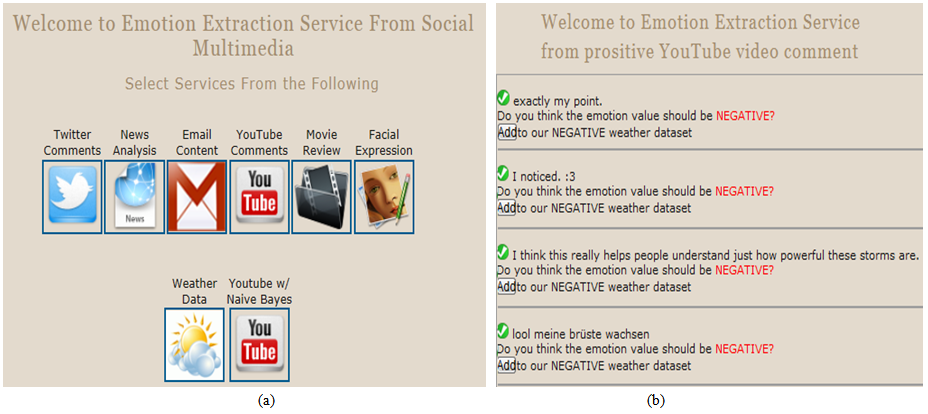 | Figure 4. (a) MediaTagger main window (b) part of MediaTagger authoring interface |
4. Evaluation and Results
- We have tested the individual components of the system shown in Figure 1. Tests have been conducted at different network traffic conditions. The test results reveal several points: first, how efficient is the Web Data Extractor to collect the content from different social networks and internet based services. Second, the performance of the emotion extraction subsystem is primarily dependent on the content extraction subsystem. Hence, the clearer and less noisy the contents are, the better the emotion extraction subsystem will perform. Finally, we have measured the time delay in extracting the contents, evaluating emotional values using either API calls or the Naïve Bayes algorithm, adding appropriate emotional tags and rendering them dynamically to respective services as shown below:
 | (2) |
|
|
5. Case Study: Event-Locations Correlation according to Users’ Emotions
- One usage of the previous emotion-based tagging of user posts could be the monitoring of peoples’ emotions about a certain event or subject. Usually, a lot of people use the social media to express their feeling about a certain event. One example of using emotion and sentiment analysis from Twitter posts is stock market prediction as in [13, 14, 15]. Another application is utilizing the emotion and sentiments of students and learners in improving the e-learning process and contents as described in [16, 17].We applied our emotion analysis for a different domain as following: Muslims (pilgrims) have an annual major event called Hajj. Hajj is one pillar of Islam. Muslims are asked to perform Hajj in Kingdom of Saudi Arabia (KSA) at least once in their life time. This event takes around 4 days to perform. Around 4 million Muslims perform Hajj every year in Makkah in KSA. The major events in these 4 days are composed of several steps in different locations in Makkah. The steps include:a) Stay in a location called Arafat.b) Stay for a period in a location called Mujdalifahc) Visit another location called Mina several daysd) Pray in the big Mosque called HaramWe made use of those facts about Hajj event to monitor the emotions of pilgrims for the Hajj 2013 event. The main objective of this task is to help Hajj administrators getting feedback from actual pilgrims about the services and organization of the past Hajj event so that they obtain good idea about the strengths and shortcomings for their plan of Hajj. This could be a useful decision-support utility in preparing for future Hajj events. Thus, we utilized our MediaTagger tool to retrieve and analyze certain keywords about Hajj to provide a summary of pilgrims’ opinions. We chose to decompose the major event topic into a two-level hierarchy or related sub-topics. We chose those sub-topics to be the locations (venues) of Hajj.In the past, several research works has been conducted about decomposing articles and posts into hierarchical structure of topics. For example, the authors in [18] extend the Hierarchical DirichletProcess (HDP) model to generate hierarchy of topics of a certain topics in very fast fashion and using much larger data sets. In [19], the authors developed an algorithm called hHDP that uses no-predefined parameters for the hierarchical structure of the document. The authors in [20] presented a semi-supervised hierarchical topic modeling. Several works [21, 22, 23] have been done in aspect-based sentiment analysis. The basic task provided in these systems is to extract key aspects and entities that have been commented on within opinion documents. Supervised sequence labeling is utilized in [24, 25] for aspect extraction. In [26], the authors show sentiment analysis using seed words for a few aspect categories that are provided by the user.Leveraging our prior works, we elected to subdivide the monitoring task according to the location of the task. We chose the root event to be “Hajj” related keywords. The children nodes would be: “Arafat”, “Haram”, “Mujdalifah” and “Mina” related keywords. We made use of twitter user posts that are searched by the mentioned keywords during the Hajj event and classified the emotions recognized through our system. Those classifications included “positive”, “neutral” and “negative” emotions. The main goal of this case study is to provide global sentiments to the Hajj authorities especially the most negative issues so that they concentrate on resolving and improving them next seasons. The study also tries to find the most correlated results among the children topics to the main topic, which is Hajj. Therefore, we ran the system multiple times for some location-based keywords. A summary of the total results is shown in figure 6.
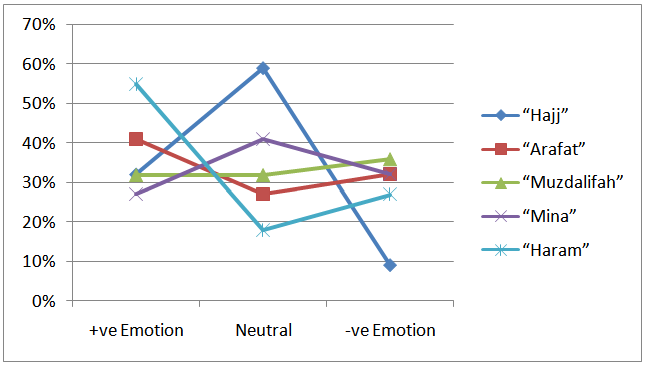 | Figure 6. Emotion results based on keywords related to “Hajj” and its venues |
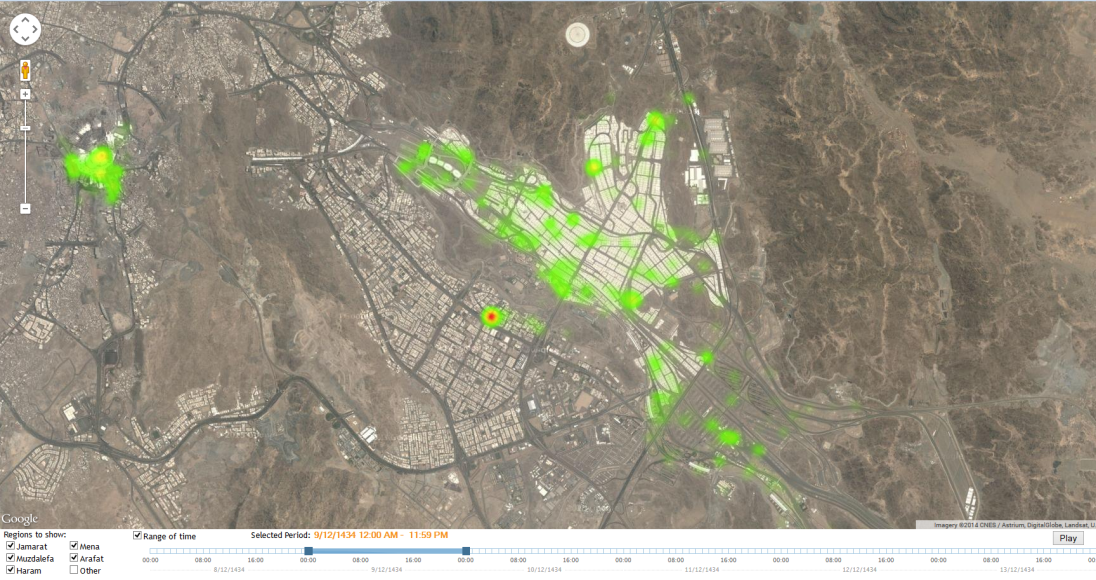 | Figure 7. Emotion results based on keywords related to “Hajj” and its venues shown as Tweet heatmap |
6. Conclusions and Future Work
- In this paper, we have presented our system called MediaTagger, which is a Web-based application that is developed to automatically handle online social media contents and add Emotion Tags for them. MediaTagger mashes up state of the art emotion extraction services. The system also makes use of a reliable supervised learning technique which is the Naïve Bayes theorem to offer authoring options to its users. Currently, the system supports certain content sources such as YouTube reviews, Twitter posts, Weather feeds, Gmail Email messages, image mood and RSS News feeds.We discussed one real-life case study that could be developed on top of our open source platform. This application is concerning the monitoring and tracking of user feedback posts concerning a major event which is this year’s Hajj event. We analyzed the emotions about the event and its venues. We showed how to infer the most related venues to the overall event as well as the most negative venue response so that the authorities and event managers would target them for improvements in the next year. We believe that in future we could make use of hierarchical topic models to reason about the reviews and feedback emotion about certain major events, brands and services.We are planning to incorporate new media analysis tools that could process other media types such as generic image and video contents. On a different front, we will incorporate a timeline interface that shows the emotions and sentiments of certain topics or keywords along the time dimension. This could be very useful for example to marketing and branding companies that need to see the effect of certain announcements and news on the brand of certain products or services and possibly forecasting the best times to launch new campaigns and releases.
ACKNOWLEDGMENTS
- This project was supported by the NSTIP strategic technologies program (11-INF1703-10, 11-INF1700-10 and 11-INF1683-10) in the Kingdom of Saudi Arabia. The author would like to thank Dua, Omayma, Shatha, Jayda, and Ahdab of Umm Al-Qura University for helping in collecting data and testing diversified services.
Notes
- 1. http://www.viralheat.com/2. http://sentistrength.wlv.ac.uk/3. http://www.mashape.com4. http://www.alchemyapi.com/5. http://developer.opendover.nl/page/Get_started_now6. http://twittersentiment.appspot.com7. http://developers.face.com/8. http://imgur.com/9. http://lymbix.com10. http://en.wikipedia.org/wiki/Hajj
 Abstract
Abstract Reference
Reference Full-Text PDF
Full-Text PDF Full-text HTML
Full-text HTML